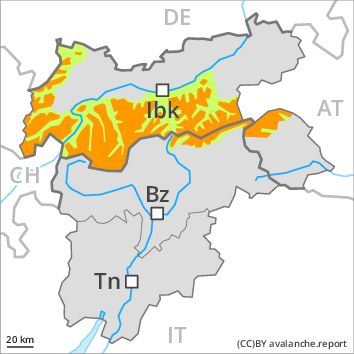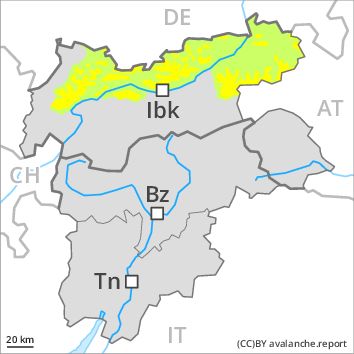Regions
Weißkugel Range, Western Verwall Mountains, Gurgler Range, Central Stubai Alps, Eastern Verwall Mountains, Northern Zillertal Alps, Allgäu Alps, Silvretta, Venediger Range, Samnaun Mountains, Southern Zillertal Alps and High Tauern, Northern Oetz and Stubai Alps, Western Tuxer Alps, Eastern Tuxer Alps, Western Lechtal Alps, Glockturm Range

Danger level
Danger Level 3 - Considerable above the treeline
Danger Level 1 - Low above the treeline
Avalanche Problem
Wind-drifted snow above the treeline, N-NE-E-SE-S-NW

Wind slabs are to be evaluated critically.
A considerable (level 3) danger of slab avalanches exists. This applies above the tree line. Fresh and somewhat older wind slabs represent the main danger. The avalanche prone locations are to be found in particular on steep northwest to north to southeast facing slopes and in gullies and bowls, and behind abrupt changes in the terrain. The number and size of avalanche prone locations will increase with altitude. Avalanches can mostly be released, even by a single winter sport participant and reach medium size. Snow sport activities outside marked and open pistes call for experience in the assessment of avalanche danger.
A latent danger of gliding avalanches exists. Caution is to be exercised in areas with glide cracks.
Snowpack
dp 6: cold, loose snow and wind
dp 5: snowfall after a long period of cold
Over a wide area 20 to 30 cm of snow. fell. In the Western Lechtal Alps and in the Western Verwall Mountains up to 60 cm of snow. fell. As the day progresses further wind slabs will form especially in the regions exposed to the foehn wind. In some cases wind slabs are lying on soft layers.
Tendency
The avalanche danger will persist.
Regions
Sexten Dolomites, Latemar, Val Müstair Alps, Langtaufers, Schnals Ridge, Southern Stubai Alps, Saldurn-Mastaun Ridge, Texel Mountains, Southern Adamello, Sarntal Alps, Adamello - Presanella, Western Pfunderer Mountains, Northern Brenta - Peller, Southern Brenta, Southern Lagorai, Northern Lagorai, Maddalene, Eastern Pfunderer Mountains, Durreck Range, Western Rieserferner Mountains, Western Deferegger Alps, Ortler Range, Ulten Valley, Eastern Nonsberger Alps, Eastern Rieserferner Mountains, Northern Dolomites of Fiemme, Glockner Range, Gröden Dolomites, Primiero - Pale di S. Martino, Eastern Deferegger Alps, Prags Dolomites, Schober Mountains, Lienzer Dolomites, Fassa Valley, Sole, Pejo and Rabbi, Paganella

Danger level
Danger Level 2 - Moderate above the treeline
Danger Level 1 - Low above the treeline
Avalanche Problem
Wind-drifted snow above the treeline, N-NE-E-SE-S-NW

Fresh wind slabs require caution.
The fresh wind slabs represent the main danger, caution is to be exercised in particular on steep shady slopes as well as adjacent to ridgelines and in gullies and bowls. The number and size of avalanche prone locations will increase with altitude. Avalanches can be released, even by a single winter sport participant and reach medium size. In regions neighbouring those that are subject to danger level 3 (considerable) avalanche prone locations are more prevalent and the danger is greater.
A latent danger of gliding avalanches exists. Caution is to be exercised in areas with glide cracks.
Snowpack
dp 6: cold, loose snow and wind
In some localities up to 5 cm of snow. fell, in particular in the north. The strong wind has transported the fresh and old snow. In some cases wind slabs are lying on soft layers.
Tendency
The avalanche danger will persist.
Regions
Karwendel Mountains, Brandenberg Alps, Western Kitzbühel Alps, Wilder Kaiser Mountains - Waidring Alps, Eastern Kitzbühel Alps, Central Lechtal Alps, Grieskogel Mountains, Eastern Lechtal Alps - Ammergau Alps, Mieming Mountains

Danger level
Danger Level 2 - Moderate above the treeline
Danger Level 1 - Low above the treeline
Avalanche Problem
Wind-drifted snow above the treeline, N-NE-E-NW

Wind slabs represent the main danger.
As a consequence of fresh snow and wind the wind slabs have increased in size. This applies in particular on steep shady slopes adjacent to ridgelines and in gullies and bowls. Mostly avalanches are rather small and can be released easily even by a single winter sport participant.
Snowpack
dp 6: cold, loose snow and wind
Over a wide area 20 to 30 cm of snow, and up to 50 cm in some localities, fell. As a consequence of a sometimes strong westerly wind, easily released wind slabs formed in particular adjacent to ridgelines and in gullies and bowls. In some cases wind slabs are lying on soft layers. This applies in particular on steep shady slopes.
No distinct weak layers exist in the old snowpack in all altitude zones. At low and intermediate altitudes a little snow is lying.
Tendency
The avalanche danger will persist.



